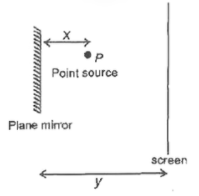A : In interference, the fringe obtained at the centre of the screen is known as zeroth order fringe, or the central fringe
R : In interference, path difference between the waves from S1 and S2, reaching the central fringe (or zero order fringe) is zero
Both A and R are true and R is the correct explanation of A
Both A and R are true and R is not the correct explanation of A
A is true and R is false
Both A and R are false
The correct Answer is:A
To solve the question, we need to analyze the two statements provided:
Statement A: In interference, the fringe obtained at the center of the screen is known as the zeroth order fringe, or the central fringe.
Statement R: In interference, the path difference between the waves from S1 and S2, reaching the central fringe (or zero order fringe) is zero.
1. Understanding Interference:
- Interference occurs when two or more waves overlap and combine, resulting in a new wave pattern. This is commonly observed in light waves.
2. Identifying the Central Fringe:
- The central fringe, also known as the zeroth order fringe, is the brightest spot in the interference pattern. It is located at the center of the screen where the two waves meet.
3. Path Difference at the Central Fringe:
- For the central fringe to occur, the waves from the two sources S1 and S2 must travel the same distance to reach the center of the screen. This means that the path difference between the two waves is zero.
4. Mathematical Representation:
- The condition for constructive interference (bright fringes) is given by the formula:
Path difference=nλ
where n is an integer (0, 1, 2, ...) and λ is the wavelength of the light. For the central fringe (zeroth order), n=0, thus:
Path difference=0⋅λ=0
5. Conclusion:
- Both statements A and R are true. Statement A correctly identifies the central fringe as the zeroth order fringe, and Statement R accurately describes that the path difference at this fringe is zero.
Final Answer:
Both statements A and R are true, and R is the correct explanation for A.
- Interference occurs when two or more waves overlap and combine, resulting in a new wave pattern. This is commonly observed in light waves.
- The central fringe, also known as the zeroth order fringe, is the brightest spot in the interference pattern. It is located at the center of the screen where the two waves meet.
- For the central fringe to occur, the waves from the two sources S1 and S2 must travel the same distance to reach the center of the screen. This means that the path difference between the two waves is zero.
- The condition for constructive interference (bright fringes) is given by the formula:
Path difference=nλ
where n is an integer (0, 1, 2, ...) and λ is the wavelength of the light. For the central fringe (zeroth order), n=0, thus:
Path difference=0⋅λ=0
- Both statements A and R are true. Statement A correctly identifies the central fringe as the zeroth order fringe, and Statement R accurately describes that the path difference at this fringe is zero.
Both statements A and R are true, and R is the correct explanation for A.
Topper's Solved these Questions
- WAVES OPTICSBook:AAKASH SERIESChapter:WAVES OPTICSExercise:EXERCISE -II (INTERFERENCE)
Explore 26 Videos
- WAVES OPTICSBook:AAKASH SERIESChapter:WAVES OPTICSExercise:EXERCISE -II (DIFFRACTION)
Explore 17 Videos
- WAVES OPTICSBook:AAKASH SERIESChapter:WAVES OPTICSExercise:EXERCISE -IA (ASCENDING AND DSCENDING ORDER TYPE QUESTIONS)
Explore 6 Videos
- WAVESBook:AAKASH SERIESChapter:WAVESExercise:EXERCISE-III (Doppler effect :)
Explore 15 Videos
Similar Questions
What is the difference between 2.0m and 2.00m.
View SolutionIn Young's double slit experiment, the phase difference between the two waves reaching at the location of the third dark fringe is
View SolutionIf the path difference between the interfering waves is nλ, then the fringes obtained on the screen will be
View SolutionShape of interference fringes formed on the screen due to point source P, in the case shown here

View SolutionTwo coherent sources of light interfere and produce fringe pattern on a screen . For central maximum phase difference between two waves will be
View SolutionInterference fringes are observed on a screen by illuminating two thin slits 1 mm apart with a light source (λ=632.8nm). The distance between the screen and the slits is 100 cm. If a bright fringes is observed on a screen at a distance of 1.27 mm from the central bright fringe , then the path difference between the waves , which are reaching this point from the slits is close to :
View SolutionIf white light is used in Young's double -slit experiment
a) bright white fringe is formed at the centre of the screen
b) fringes of different colours are observed on both sides of central fringe clearly only in the first order
c) the first order violet fringes are closer to the centre of the screen than the first order red fringes
d) the first order red fringes are closer to the centre of the screen than the first order violet fringes
View SolutionIn Young.s double slit experiment, what is the path difference between the two light waves forming 5th bright band (fringe) on the screen ?
View SolutionIn Young.s double slit experiment, the 10th bright fringe is at a distance x from the central fringe. Then
a) the 10th dark fringe ia at a distance of 19x/20 from the central fringe
b) the 10th dark fringe is at a distance of 21x/20 from the central fringe.
c) the 5th dark fringe is at a distance of x/2 from the central fringe. d) the 5th dark fringe is at a distance of 9x/20 from the central fringe.
View SolutionA fringe width of a certain interference pattern is β=0.002 cm What is the distance of 5th dark fringe centre?
View Solution

